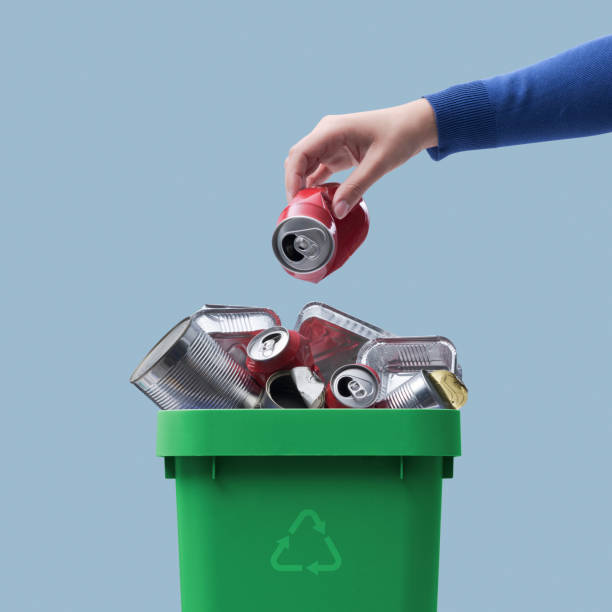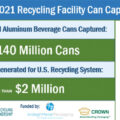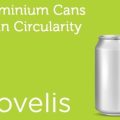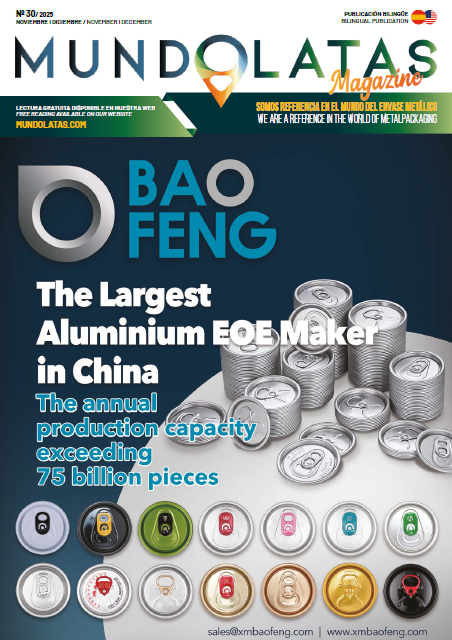The latest data from the Aluminum Association and the Can Manufacturers Institute (CMI) found that the recycling rate of the aluminum beverage can in the United States has declined in recent years amid an aging recycling infrastructure and a passive approach to recycling policy.
These data come from surveys of aluminum can recyclers and manufacturers, government and other data sources and found that 43% of aluminum cans shipped to the U.S. in 2023 were ultimately recycled, well below an average rate of about 52% since tracking began in 1990. While this still comfortably exceeds the equivalent recycling rate for glass (39.6%) and plastic (PET) bottles (20.0%), recycling rates for aluminum cans are at their lowest point in decades.
“Our current approach to recycling in the U.S. is simply not working at the level we need it to.” said Charles Johnson, president and CEO of the Aluminum Association. “While we recycle more than 46 billion cans in 2023, we throw away more than 61 billion cans, that’s an average of about 15 twelve-packs of cans for every person in the country. That’s almost $1.2 billion worth of aluminum that ends up in a landfill every year. That’s bad for the economy, the environment and national security. It also puts the U.S. at the bottom of aluminum can recycling compared to other countries.”
“More coordinated action and greater long-term strategic investments are needed to increase the recycling rate of aluminum beverage cans,” said CMI President Robert Budway. “Our recycling roadmap demonstrates how we can achieve our goals of a 70 percent recycling rate by 2030, 80 percent by 2040 and 90 percent by 2050. We recognize that achieving these targets will be a challenge that requires strategies tailored to our unique and diverse policy environment. Certain policy prescriptions, such as comprehensive extended producer responsibility laws that include recycling rebates (deposit return systems), will greatly enhance beverage container recovery. However, not all local jurisdictions will take these frameworks into account. CMI members are also focused on improving access to in-home and out-of-home recycling, increasing consumer education for recycling, and developing more efficient sorting of aluminum beverage cans at recycling centers to help achieve our goals.”
Beyond consumer recycling rates, The Aluminable Can Advantage: Sustainability Key Performance Indicators report shows that the aluminum can continues to have significant sustainability advantages over competing material types, such as plastic (PET) and glass.
Other findings from the report include:
⦁ The industry recycling rate, which includes recycling of all used aluminum beverage containers (UBC) by the U.S. industry (including imported and exported UBC) stands at 57%, close to the 30-year average of ~60%.
⦁ The closed-loop circularity rate increased more than 4 points since the last report to 96.7%. This compares to 34% for PET bottles and between 30% and 60% for glass bottles.
⦁ The average recycled content of an aluminum can manufactured in the United States is 71%, slightly below the 73% reported in 2019, but far exceeding glass bottles (23%) and plastic bottles (3-10%).
⦁ The aluminum can remains by far the most valuable beverage package in the recycling garbage can, with a value of $1,338/ton compared to $215/ton for PET and a negative value of $23/ton for glass, based on a two-year moving average through February 2024.
The Aluminum Association and CMI are working with a number of organizations, including can manufacturers, beverage brands, environmental organizations and policy think tanks on new approaches to drive increased recycling in the United States, as detailed in the Aluminum Beverage Can Recycling Rate Goals Progress Report also released today. One promising approach is the expansion of recycling rebate programs (also known as container deposits) to more states. According to the 50 States Recycling Report, 8 of the top 10 states for aluminum can recycling have recycling rebate policies. The 10 states with such programs boast an average aluminum can recycling rate of 68% compared to an average of 22% in non-refund states.
The Aluminum Association and CMI are also working at the federal level to support passage of two bipartisan bills by the end of the 118th Congress that would significantly improve recycling systems in the United States. The Recycling Infrastructure Accessibility Act (RIAA) and the Recycling and Composting Accountability Act (RCAA) will increase access to recycling services and improve tracking of recycled material that is essential to supply chain security, the sustainable economy and America’s manufacturing base.














